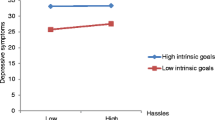Abstract
Strikingly high prevalence rates of symptoms of disordered eating among college women have been documented. The question arises as to whether one aspect of the college experience, achievement orientation, is associated with disordered eating. Competing hypotheses may be generated regarding the relationship between achievement orientation and disordered eating, with arguments for either a positive or negative relationship. The Work and Family Orientation Questionnaire (WOFO) and the Disordered Eating Symptoms Scale (DESS) were administered to 668 female undergraduate college students. Multivariate analysis of the WOFO subscales revealed that women with high levels of disordered eating obtained significantly higher scores on the Competitiveness subscale than women with low DESS scores. These findings support hypotheses of a positive relationship between competitiveness and disordered eating.
Similar content being viewed by others
References
Brownmiller. S. (1984). Femininity. New York: Simon & Schuster.
Bruch, H. (1978). The golden cage: The enigma of anorexia nervosa. Cambridge, MA: Harvard University Press.
Chernin, K. (1985). The hungry self; women, eating and identity. New York: Harper & Row.
Drewnowski, A., Yee, D. K., & Krahn, D. D. (1988). Bulimia in college women: Incidence and recovery rates. American Journal of Psychiatry, 145, 753–755.
Fiske, E. B. (1988). Selective guide to colleges. New York: Times Books.
Garner, D. M., Olmsted, M. P., & Garfinkel, P. E. (1983). Does anorexia nervosa occur on a continuum? Subgroups of weight-preoccupied women and their relationship to anorexia nervosa. International Journal of Eating Disorders, 2, 11–20.
Halmi, K. A., Falk, J. R., & Schwartz, E. (1981). Binge-eating and vomiting: A survey of a college population. Psychological Medicine, 11, 697–706.
Hawkins, R. C. II, Turell, S., & Jackson, L. J. (1983). Desirable and undesirable masculine and feminine traits in relation to students' dieting tendencies and body image dissatisfaction. Sex Roles, 9, 705–718.
Helmreich, R. L., & Spence, J. T. (1978). The work and family orientation questionnaire: An objective instrument to assess components of achievement motivation and attitudes toward family and career. JSAS Catalog of Selected Documents in Psychology, 8, 355.
Horner, M. S. (1972). Toward an understanding of achievement-related conflicts in women. Journal of Social Issues, 28, 157–175.
Kimele, G., Slade, P. D., & Dewey, M. E. (1987). Factors associated with abnormal eating attitudes and behaviors: Screening individuals at risk of developing an eating disorder. International Journal of Eating Disorders, 6, 713–724.
Pyle, R., Halvorson, P., Neuman, P., & Mitchell, J. (1986). The increasing prevalence of bulimia in freshman college students. International Journal of Eating Disorders, 5, 631–647.
Rodin, J., Silberstein, L. R., & Striegel-Moore, R. H. (1985). Women and weight: A normative discontent. In T. B. Sonderegger (Ed.), Nebraska Symposium on Motivation: Vol. 32. Psychology and gender. Lincoln: University of Nebraska Press.
Rodin, J., Striegel-Moore, R. H., & Silberstein, L. R. (1990). Vulnerability and resilience in the age of eating disorders: Risk and protective factors for bulimia nervosa. In J. E. Rolf, A. Masten, D. Cicchetti, K. Neuchterlein, & S. Weintraub (Eds.), Risk and protective factors in the development of psychopathology. Cambridge, England: Cambridge University Press.
Schotte, D. E., & Stunkard, A. J. (1987). Bulimia vs. bulimic behaviors on a college campus. Journal of the American Medical Association, 258, 1213–1215.
Spence, J. T. (1985). Gender identity and its implications for the concepts of masculinity and femininity. In T. B. Sonderegger (Ed.), Nebraska Symposium on Motivation: Vol. 32, Psychology and gender. Lincoln: University of Nebraska Press.
Spence, J. T., & Helmreich, R. L. (1978). Masculinity and femininity: Their psychological dimensions, correlates, and antecedents. Austin: University of Texas Press.
Straughn, C. T. II., Straughn, B. L. (1987). Lovejoy's college guide. New York: Monarch Press.
Striegel-Moore, R. H., Silberstein, L. R., Frensch, P., & Rodin, J. (1989). A prospective study of disordered eating among college students. International Journal of Eating Disorders, 8, 499–510.
Vincent, L. M. (1979). Competing with the sylph: Dancers and the pursuit of the ideal body form. Kansan City, KS: Andrews & McMeel.
Zuckerman, D. M., Colby, A., Ware, N. C., & Lazerson, J. S. (1986). The prevalence of bulimia among college students. American Journal of Public Health, 76, 1135–1137.
Author information
Authors and Affiliations
Additional information
This work was funded by the John D. and Catherine T. MacArthur Foundation Network on Determinants and Consequences of Health-Promoting and Health-Damaging Behavior.
Rights and permissions
About this article
Cite this article
Striegel-Moore, R.H., Silberstein, L.R., Grunberg, N.E. et al. Competing on all fronts: Achievement orientation and disordered eating. Sex Roles 23, 697–702 (1990). https://doi.org/10.1007/BF00289257
Issue Date:
DOI: https://doi.org/10.1007/BF00289257




